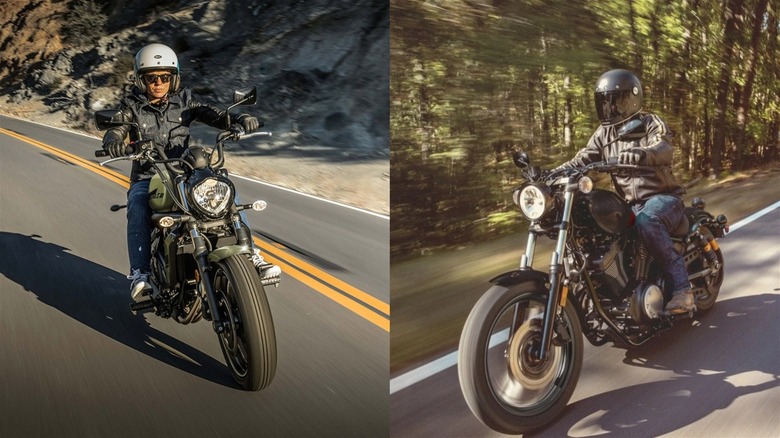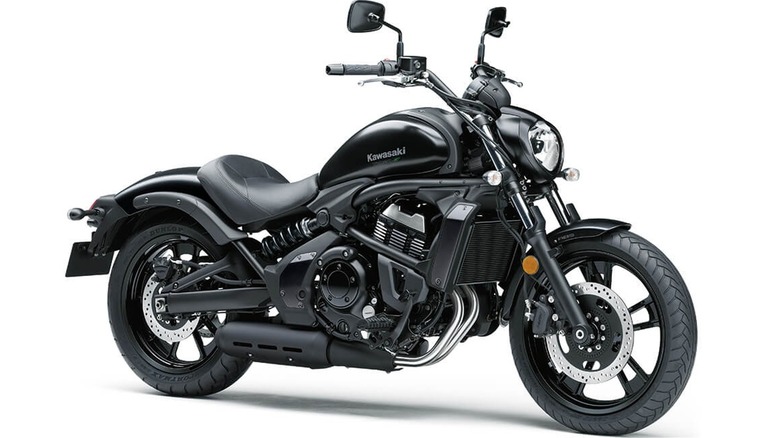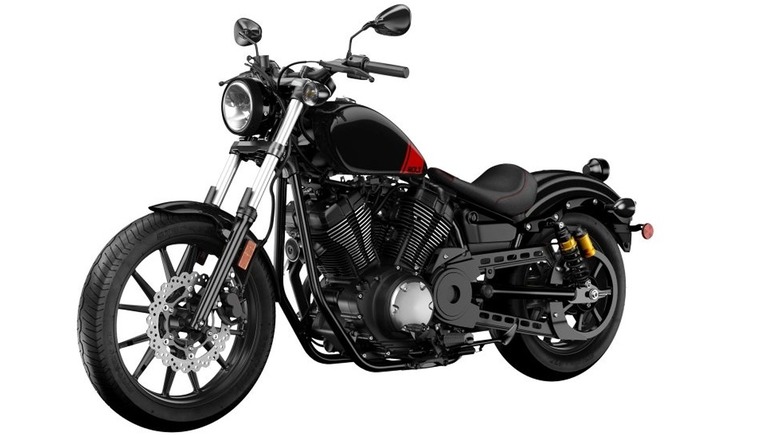Kawasaki Vulcan S Vs. Yamaha Bolt R-Spec: What's The Difference Between These Bikes?
The modern cruiser motorcycle was an invention of the 70s, and both Kawasaki and Yamaha began crafting their take on the genre shortly after its creation. There are plenty of advantages to this type of bike, including its generally low seat height and more ergonomic riding position. However, some modern cruisers may not offer the same level of suspension or be as quick to maneuver as other categories of bikes. The Kawasaki Vulcan line started in the mid-80s, while the Vulcan S debuted more recently in 2015. Where as Yamaha's Bolt series started in 2014, with the R-Spec launching later that year.
There are several differences between the Vulcan S and Bolt R-Spec, but the most striking are comfort, safety features, and weight. The Kawasaki Vulcan S includes their ERGO-FIT system, which allows for a customized riding position, whereas the Yamaha Bolt R-Spec doesn't feature those adjustments. However, the rear shocks on the Bolt-R-Spec could provide a smoother ride, unlike the Vulcan S, which has been said to feel stiff to some riders. The Kawasaki offers a Vulcan S that includes ABS (anti-lock braking system), while it is curiously absent on the base model 2024 Bolt R-Spec. While the Yamaha includes a larger engine, it's also considerably heavier than the Kawasaki, which could make controlling the bike more challenging.
ERGO-FIT and ride quality
Modern cruisers benefit from a more upright rider posture, which allows the arms to relax, the feet to push forward, and the back to straighten. The Kawasaki Vulcan S has the added advantage of the company's proprietary ERGO-FIT system. Since no two riders are the same size, the Vulcan S allows you to adjust the foot pegs, handlebars, and seat. Some parts can simply be moved into another position, like the foot pegs, while others can be switched out, like the seat. A 2015 review of the Vulcan S ABS from 5-foot 3-inch Christina Orris explained, "after a few hours on the bike I found the short reach seat to be a bit constricting, as it really limited my movement on the bike, and I rode back to Kawi HQ to swap out for the Mid-Reach seat."
In terms of ride quality, where the rear suspension is critical, Yamaha received higher praise in this category. One reviewer stated in 2021, "The rear shocks absorbers are excellent, going through unexpected bumps and make it easy for anyone's limbs." This model, according to owners, is also considered one of the best Yamaha motorcycles for long rides. In contrast, the Vulcan received some criticism from at least one reviewer who stated, "My only real complaint about the bike is in the suspension department, as it seems like the suspension is set up for a much heavier rider. I found myself getting bounced around quite a bit on bumpier roads."
ABS and control
Another area in which these two modern cruisers differ is in terms of safety technology. A review in 2021 described the ABS system on the Yamaha Bolt R-Spec, but strangely, it's absent on the latest 2024 model. The Kawasaki Vulcan S does offer an ABS model, which is something to consider when looking for the safest motorcycles to ride. A 2013 study by the Insurance Institute For Highway Safety found that ABS was responsible for a 31% drop in motorcycle accident deaths.
Maneuverability and control also have a significant impact on riding safety, especially in congested city environments. The heavier a motorcycle's weight, the more challenging it is to handle, particularly at low speeds. The Yamaha Bolt R-Spec features a larger engine at 942ccs versus the Vulcan's smaller displacement of 649cc. Although, even with less displacement, you'd be surprised how fast the Kawasaki Vulcan S goes.
So, it's not surprising that the Yamaha weighs more, but the difference in heft is noticeable between the two bikes. The Kawasaki has a curb weight of 498.3 pounds with ABS, and 491.7 pounds without ABS. The Yamaha, on the other hand, is 542 pounds making it between 43.7 and 50.3 pounds heavier. The effect this will have on the experience depends on the rider but could influence the level of control in some circumstances.


